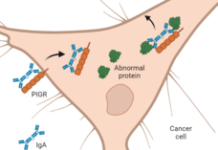Patients receiving immune checkpoint inhibitor (ICI) treatment who developed a rheumatic immune-related adverse event (irAE) displayed symptoms that resembled classical rheumatic and musculoskeletal diseases (RMDs), but seldom fulfilled their classification criteria mainly due to dissimilar laboratory characteristics. These and other findings were presented by Dr Karolina Benesova of the Department of Medicine V, Haematology, Oncology and Rheumatology, University Hospital in Heidelberg, Germany at the ESMO Virtual Congress 2020.
Dr Benesova discussed the occurrence and characteristics of rheumatic irAEs which have been associated with better tumour response following treatment with ICIs. She initiated the open-end TRheuMa registry, a prospective long-term observational study, to obtain real world data on patient characteristics and to determine the optimal clinical management of rheumatic irAEs. This study involves a patient cohort coping with rheumatic side effects of cancer therapies and is part of the large MalheuR project initiated in July 2018 at the University Hospital Heidelberg to explore interrelations of malignancies and RMDs.
TRheuMa registry provides real world data on rheumatic irAEs and patients outcome
By now, 65 patients have been recruited with a rheumatic irAE under ICI treatment; of these, 30 patients were treated with nivolumab, 33 with pembrolizumab, 12 patients with ipilimumab, 6 patients received treatment with a PD-L1 inhibitor and 10 patients received treatment with a combination of ICI agents.
The patient population comprised 47.7% of patients with NSCLC and 40.0% of patients with melanoma. In local cohorts of patients receiving ICI, 4.1% of NSCLC (n total=888) and 13.3% of melanoma (n total=195) developed a rheumatic irAE.
Flares of a pre-existing RMD were experienced by 15.4% of study patients and 9.2% of patients had an initial manifestation of a classical RMD. The de novo rheumatic irAEs primarily resembled the phenotypes of rheumatoid arthritis in 24.1% of patients, polymyalgia rheumatica in 16.7%, or spondyloarthritis in 46.3% of patients.
However, the de novo rheumatic irAEs presented with different laboratory findings, including mostly negative or unspecific autoantibodies and elevated CRP-levels in 77.4% of patients. On the basis of the clinical manifestations, CRP levels were often significantly higher than would be expected in classical RMDs and showed values >50 mg/L in 30.6% of patients.
Furthermore, 96.1% of the patients had signs of inflammation upon ultrasound examination with often symmetrical synovialitis and/or tenosynovialitis in the majority of cases.
According to a severity-based treatment algorithm developed by the investigators, therapy with ≤10 mg prednisone with/without NSAID was sufficient to resolve the irAEs in 53.8% of patients, but 15.4% required add-on cs-/bDMARD therapy. Ten (15.4%) patients discontinued ICI treatment temporarily or permanently due to the rheumatic irAE.
Interestingly, 48.0% of patients with a rheumatic irAE in this study compared with 4% of patients without an irAE in a historical control achieved complete remission of melanoma as best response and 45.8% of irAE-patients showed longstanding complete remission also as current outcome. In NSCLC patients, 69.0% reached a partial remission as best possible response.
Conclusions
According to the authors, these prospective real world data from the TRheuMa registry show that rheumatic irAEs mostly resemble classical RMDs with some distinct characteristics. Their clinical management strategy was effective and underlined a patient centred and interdisciplinary approach. Research on this immunological intersection between malignancies and RMDs offers the opportunity for better patient centred care and scientific progress.
The investigators future research agenda includes long-term observation of rheumatic irAEs and correlation with specific oncological outcomes.
Dr. Benesova is now supported by the medical faculty of the University of Heidelberg, Germany to advance the MalheuR project.
Reference
1809O – Benesova K, Diekmann L, Lorenz H-M, et al. TRheuMa registry provides real world data on rheumatic immune-related adverse events. ESMO Virtual Congress 2020.








